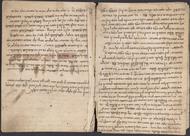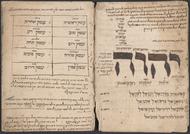CAJS Rar Ms 489 Pesukim ṿe-tserufe shemot ʻal derekh ha-ḳabalah le-Rosh ha-Shanah ule-Yamim Noraʼim. / [פסוקים וצרופי שמות על דרך הקבלה לראש השנה ולימים נוראים]
Title
Pesukim ṿe-tserufe shemot ʻal derekh ha-ḳabalah le-Rosh ha-Shanah ule-Yamim Noraʼim.[פסוקים וצרופי שמות על דרך הקבלה לראש השנה ולימים נוראים]
Authors
- Yaḥya, Avraham, 17th century
יחיעא, אברהם - Jacob, of Orleans, -1189
יעקב - Moses, ha-Darshan, active 11th century
משה - Hai ben Sherira, 939-1038
האי בן שרירא גאון - Azikri, Eleazar ben Moses, 1533-1600
אזיקרי, אלעזר בן משה - Spira, Nathan Nata ben Solomon, approximately 1585-1633
שפירא, נתן נטע בן שלמה
Other related names
- Moldovan, Joseph, donor
- Moldovan, Susan, donor
Call number
CAJS Rar Ms 489(420 Walnut Street, Philadelphia, Pennsylvania 19106-3703, University of Pennsylvania, Library at the Herbert D. Katz Center for Advanced Judaic Studies)
Alternate identifiers
- bibid: 9977510241303681
- http://www.worldcat.org/oclc/1097354887
Publisher
University of PennsylvaniaLanguage
Hebrew and AramaicOrigin
- Date
- between 1600 and 1633
- Place
-
Italy?
Summary
This is a manuscript of a liturgical miscellany with many diverse kabbalistic elements to it. It begins with a silent prayer for the cantor on the High Holidays, supplying verses to meditate on and guaranteeing that the audience will not have a harmful verdict ("gezerah raʻah") for the upcoming year (f. 1r-1v). The prayer ends with additional texts, titled "Ḳabalot", of verses to recite with supplications; the first attributed to R.T. (likely a reference to Jacob of Orléans (died 1189), also known as Rabbenu Tam) and the second attributed to Rav Mosheh ha-Darshan (11th century Narbonne, f.1v-2r). Following this, after a space, is a transcription of a riddle which, by the use of notarikon, claims to develop a definite date for the arrival of the Messiah, based on Micah 2:12; the author attributes this text to "an ancient miscellany ("Ḳovets yashan") written by the wise R. Hai son of R. Sherira Ga'on, [and when] he was asked about the 'end-days of wonders'" ("Ḳets ha-pelaʼot," quoting Daniel 12:6); this attribution is to R. Hai b. Sherira Gaon (Iraq, 939-1038, f. 2r). Following this is a prayer for one to remove unwanted thoughts while praying (f. 3v). Also on that folio is the poem Yedid nefesh, with an inscription in a late 17th-century Sefardic cursive hand, "ידיד נפש לר' אלעזר", or "Yedid nefesh by R. Elazar." Following are the Ten Commandments as written in the Pentateuch (Exodus 20:1-14, f. 3v). Following this is the Tiḳune ha-Zohar chapter 17 (begining "Ribon ha-ʻolamim," f. 4r). Following is a page of commentary of practices for Rosh ha-Shanah and Yom Kippur, from the author's teacher; some of it is attributed to this teacher's correspondence with R.B.L. (unknown reference, f. 4v). Following is a kabbalistic dissertation (titled "Diḳduḳ") involving variations of verses drawn seemingly at random; this is followed by a colophon and the signature of the author (f. 6r). Following this is an amulet text. Following is a chart with terminology for the sefirot, attributed by the author to R. Natan Spira. At the bottom of the folio is further laws pertaining to behaviors for the High Holidays (f. 7r). Following this is a divine prayer with diagrams of the letter ṿaṿ in different vowel structures for the purpose of both recitation and meditation (f. 7v-9r). The manuscript finishes with a prayer for sea travelers to be protected from the dangers of ocean voyages.
Notes
- 1. f. 1r-1v: [Tefilah] le-mi she-ʻover li-fene ha-tevah be-R.H. ṿe-Y. ha-K. -- 2. f. 2r: Ḳabalah / me-R. Mosheh ha-Darshan -- 3. f. 2r: Heʻteḳ ... meḳubal yashan [ʻal zeman ḳets ha-pelaʼot] -- 4. f. 3r: Tefilah yafah le-omro be-khol yom uve-khol zeman ha-tefilah -- 5. f. 3v: [Tefilah] le-hasir maḥshavot raʻim be-ʻet ha-tefilah -- 6. f. 3r: Yedid nefesh -- 7. f. 3v: [ʻAśeret ha-dibrot] -- 8. f. 4r: [Tiḳune ha-Zohar 17] -- 9. f. 4v: Dinim ha-shayakhim le-R.H. ṿe-Y.ha-K. -- 10. f. 5r-6r: Diḳduḳ [...] le-havin ule-horot amarot ṭehorot -- 11. f. 6v: [Ḳameʻa] -- 12. f. 7r: [Seder] be-khitve / ḥaveri ha-R.N. Śpira -- 13. f. 7v-9r: Seder ha-yiḥud ha-gadol ha-mesugal leha-shanah -- 14. f. 9v: Tefilat ha-yam ʻal kol tsarah she-lo tavo.
- Ms. gatherings.
- Title supplied by cataloger.
- 1. f. 1r-1v: [Tefilah] le-mi she-ʻover li-fene ha-tevah be-R.H. ṿe-Y. ha-K. -- 2. f. 2r: Ḳabalah / me-R. Mosheh ha-Darshan -- 3. f. 2r: Heʻteḳ ... meḳubal yashan [ʻal zeman ḳets ha-pelaʼot] -- 4. f. 3r: Tefilah yafah le-omro be-khol yom uve-khol zeman ha-tefilah -- 5. f. 3v: [Tefilah] le-hasir maḥshavot raʻim be-ʻet ha-tefilah -- 6. f. 3r: Yedid nefesh -- 7. f. 3v: [ʻAśeret ha-dibrot] -- 8. f. 4r: [Tiḳune ha-Zohar 17] -- 9. f. 4v: Dinim ha-shayakhim le-R.H. ṿe-Y. ha-K. -- 10. f. 5r-6r: Diḳduḳ [...] le-havin ule-horot amarot ṭehorot -- 11. f. 6v: [Ḳameʻa] -- 12. f. 7r: [Seder] be-khitve / ḥaveri ha-R.N. Śpira -- 13. f. 7v-9r: Seder ha-yiḥud ha-gadol ha-mesugal leha-shanah -- 14. f. 9v: Tefilat ha-yam ʻal kol tsarah she-lo tavo.
- No binding; fragile remnants of sewing. Heavy wear and darkening on the leaves and writing.
Extent
10 leaves : 150 x 105 mmCollation
Paper, 10; 1², 2 detached leaves, 2² 3⁴; modern foliation in pencil, 1-10, center left recto.Support
PaperLayout
Script
Provenance
- GIFT FROM THE MOLDOVAN FAMILY COLLECTION By Joseph T. Moldovan C'76 and Susan A. Moldovan C'76. Donated in Honor and Memory of Jean and Dr. Alfred Moldovan.
Subjects topical
- Cabala--Early works to 1800
- Messiah--Judaism--Early works to 1800
- Judaism--Prayers and devotions--Early works to 1800
- Judaism--Prayers and devotions
- Messiah--Judaism
- Cabala
Genres
- Codices (bound manuscripts)
- Miscellanies
- Prayers
- Prayers
- Devotional literature
- Devotional literature
- Manuscripts, Hebrew
- Manuscripts, European
- Prayers
- Devotional literature
Licenses
-
- Text
- These images and the content of Library at the Herbert D. Katz Center for Advanced Judaic Studies CAJS Rar Ms 489: Pesukim ṿe-tserufe shemot ʻal derekh ha-ḳabalah le-Rosh ha-Shanah ule-Yamim Noraʼim. are free of known copyright restrictions and in the public domain. See the Creative Commons Public Domain Mark page for usage details, http://creativecommons.org/publicdomain/mark/1.0/.
- URL
- http://creativecommons.org/publicdomain/mark/1.0/
-
- Text
- Metadata is ©2023 University of Pennsylvania Libraries and licensed under a Creative Commons Attribution License version 4.0 (CC-BY-4.0 https://creativecommons.org/licenses/by/4.0/legalcode. For a description of the terms of use see the Creative Commons Deed https://creativecommons.org/licenses/by/4.0/.
- URL
- https://creativecommons.org/licenses/by/4.0/legalcode
Images
 None
Nonecajs_rar_ms_489_body0016.tif (289.3 MB)
cajs_rar_ms_489_body0016_thumb.jpg (2.8 KB)
cajs_rar_ms_489_body0016_web.jpg (203.2 KB)











